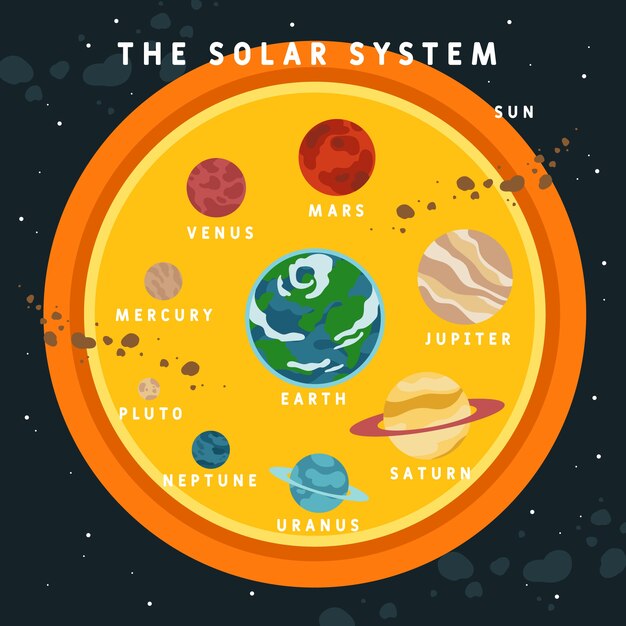Exploring Uranus – Fascinating Facts You Need to Know

Uranus is the seventh planet from the Sun, but it was the first planet discovered using a telescope.
Uranus is unique in our solar system because it rotates on its side, almost like it’s rolling along its orbit.
Uranus gets its distinct blue-green color from the methane gas in its atmosphere.
The name Uranus comes from Greek mythology, specifically from the god of the sky, Ouranos.
Uranus has the coldest atmosphere in our solar system, with temperatures dropping as low as -224 degrees Celsius.
Despite its frigid temperatures, Uranus emits a surprising amount of heat due to its internal processes.
Uranus has 27 known moons, with the largest one being named Miranda.
The magnetic field of Uranus is incredibly unique, as it is tilted at a 60-degree angle compared to the planet’s rotation.
Uranus has rings, though they are much less visible than those of Saturn. These rings were discovered in 1977.
The rings of Uranus have an odd coloring, with some portions appearing red and others blue.
The atmosphere of Uranus is comprised mainly of hydrogen and helium, similar to the gas giants Jupiter and Saturn.
Uranus is more than four times larger than Earth, making it the third-largest planet in our solar system.
The first flyby of Uranus occurred in 1986 when NASA’s Voyager 2 spacecraft passed by the planet providing invaluable data and images.
The axial tilt of Uranus is so extreme that its poles experience 42 years of constant daylight, followed by 42 years of darkness.
Exploring Uranus – Fascinating Facts You Need to Know part 2
The rings of Uranus are named after scientists and characters from William Shakespeare’s plays.
Uranus has a very thin ring system, consisting of thousands of particles, rather than solid rings.
The atmosphere of Uranus is composed of 83% hydrogen, 15% helium, and trace amounts of methane and other compounds.
The blue color of Uranus is believed to be caused by methane, which absorbs red light and reflects blue light.
Uranus has faint cloud bands similar to Jupiter and Saturn, but they are much less distinct.
The temperature on Uranus doesn’t vary much across its surface, as the weather patterns are relatively calm.
Uranus has a cap of methane clouds that can be seen by telescopes.
Despite its unique qualities, Uranus is often referred to as the boring planet due to its lack of distinct features visible from Earth.
The Voyager 2 spacecraft discovered at least 10 new moons around Uranus.
Uranus was officially recognized as a planet in 1783, eight years after its discovery by William Herschel.
Uranus takes about 84 Earth years to orbit the Sun once.
Uranus has been visited by only one spacecraft, Voyager 2, which provided detailed images of the planet’s atmosphere and moons.
Uranus experiences seasons that last about 20 Earth years each due to its extreme axial tilt.
The rings of Uranus are made up of dark particles, likely composed of a mixture of rock and ice.
Uranus gets its blue-green color from the absorption and scattering of sunlight by its atmosphere.
Uranus has a diameter of about 51,800 kilometers, making it roughly four times wider than Earth.
Astronomers believe that Uranus may have a large, rocky core surrounded by icy layers.
Uranus has a faint, undulating magnetic field that is about 50 times weaker than that of Earth.
Uranus is not visible to the naked eye from Earth, and its discovery required the use of a telescope.
Some theories suggest that Uranus was impacted by a massive object, causing its extreme axial tilt.
Uranus has a total of 13 rings, with the brightest and most prominent being known as the epsilon ring.
Uranus has a relatively calm atmosphere, with winds blowing at speeds much slower than those on other gas giants.
The interior of Uranus is likely composed of a mixture of rock and ice, under massive pressure due to its massive size.
Uranus has a total of 17 known moons, but more may be discovered in the future.
Despite its cold temperatures, Uranus experiences strong storms in its atmosphere, including extremely high-speed winds.
Uranus appears as a featureless disk even when observed through large telescopes due to its lack of distinct cloud formations.
Uranus has a mass 14.5 times that of Earth, and it is mostly made up of hydrogen and helium.
Uranus has an average density that is about 1.27 times that of water, making it one of the least dense planets in our solar system.
The discovery of Uranus expanded our understanding of the solar system and paved the way for further exploration.
Uranus has a faint, hazy outer layer known as the methane stratosphere, which contributes to its unique appearance.
Studying Uranus and its unique characteristics can provide valuable insights into the formation and evolution of our solar system.

